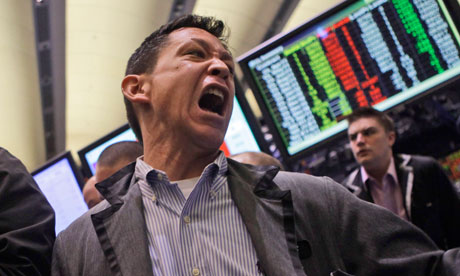Gaddafi blamed the revolt on al-Qaida leader Osama bin Laden, and said the protesters were fuelled by hallucinogenic drugs.
Contrarian Investor UK invests mainly in UK FTSE and AIM listed shares. Like famous contrarians, Warren Buffett and Anthony Bolton, he likes to take a different view to the crowd of investors. He prefers the short term, possibly speculative trade, to the long term hold and takes the view that it's about "buy and research" not "buy and hold"! This blog tracks Contrarian Investor UK's thoughts on the stockmarket and his portfolio's trades. Move against the herd with the Contrarian Investor UK!
Trades and observations from a British contrarian stock investor
Thursday, February 24, 2011
Gaddafi loses control outside Tripoli and oil price turns down
Gaddafi blamed the revolt on al-Qaida leader Osama bin Laden, and said the protesters were fuelled by hallucinogenic drugs.
Gulf Keystone dropping like a rock
Despite a rising oil price, GKP is dropping as fears continue to grow that factions in Kurdistan may try and break away from Iraq. Also that the contracts that the semi-autonomous government has signed may be torn up leaving foreign oil companies with nothing more than pieces of paper.
There's plenty of good shares in the nice and secure North Sea before you start putting your money into Iraq (Encore, Nautical, Xcite etc.) . The risk/reward is in favour of the sellers at the moment. Institutions are selling and it would not be surprising to see this below 120p. If you compare two Frontier explorers, GKP with RKH, the latter is far less risky as its assets are more secure and there is no litigation hanging over it. Even if RKH is in the South Atlantic, its still UK sovereign territory!
Big day of earnings U.K. Market
2010 Losses at RBS were double that expected at £1.1 billion, though the operating profit before write downs was £1.9 billion, compared with a £6.1 billion loss in 2009. Bad debt losses were £9.3 billion versus nearly £14 billion in 2009. The shares are down 3% to 46p.
British American Tobacco (BATS) reported pre-tax profits up 5% to £4.3 billion. Volumes were down 2% overall to 708 billion with a 1% decline in the Americas, and 8% lower in Western Europe, but these were offset by higher prices. The operating margin grew 2% and earnings per share grew by 6% to 145p. The total dividend increased 15% to 114p and a £750 million share buy back was started. The shares are down 2.5% to £23.54, with disapointment about the size of the share buy back (presumably smaller fund acquisitions).
Centrica (CNA) waz flat at 334p, after announcing pre-tax profits of £2.8 billion, up from £1 billion a year ago. Revenue was broadly flat at £22 billion. British gas added 267,000 customers in 2010, despite a 7% price increase. They said wholesale gas prices rose substantially in the final quarter of 2010, meaning a lower margin.
Brent crude oil hits $119
Brent crude oil for April delivery went up as high as 6% this morning, $17 in the last week. Worries about Libya and possible contagion to other oil producing states were behind the rise. No one wants to be left short if things kick off in the Middle East, triggering panic buying. Its incredible to think that oil dropped to close to $20 during 2009.
FT.com February 23rd - Bowleven and Encore Oil
By Bryce Elder
Published: February 23 2011 19:39 | Last updated: February 23 2011 19:39
Bowleven rose 3.2 per cent to 323p after Goldman Sachs added the oil explorer to its “conviction buy” list on valuation grounds. Investors were putting no value to Bowleven’s drilling campaign due to start at the Etinde field offshore Cameroon, even though success had the potential to lift the stock above £10, the broker said.
Encore Oil was up by 3.7 per cent to 120½p following press speculation that Premier Oil would agree a bid of around 220p per share for its North Sea peer before May.
“First up, it would be bizarre, in our view, if two companies had agreed a price for a deal and then waited for up to two months to announce it,” said RBS analyst Phil Corbett, who also doubted whether Encore’s exploration portfolio would be of interest to Premier. “Given the market tends to place much greater value on exploration than the industry, and Premier’s only major foray into corporate acquisitions in recent years was through the distressed sale of Oilexco, we would discount these reports for now,” he said.
Source: http://www.ft.com/cms/s/0/eb2119da-3f7e-11e0-a1ba-00144feabdc0.html#axzz1ErFqLn2A
Guardian - Oil price could hit $220 a barrel
Oil price 'could hit $220 a barrel'

Last Caterpillar earnings call points to solid 2011 global economic recovery
It was interesting to read the last Caterpillar (CAT) conference call, made in late January to accompany the Q4 2010 results. I have highlighted some of the key bits below from the transcript of the earnings call. Given Caterpillar manufactures machines and other equipment for the construction and mining sector it is considered to be a litmus test for the state of the global economy, Caterpillar is a key company to follow. During 2009 its share price collapsed to around $20, it is now $100 - incredible for a 5 bagger with such a mega cap company!
We expect profit again to be near $6 a share, an increase from $4.15 in 2010 and above the 2008 record of $5.66 a share. And recall, the $5.66 from 2008 included large favorable tax items that resulted in a tax rate that year near 19%. So on a before-tax basis, we expect to do even better than the headline number would indicate relative to the prior 2008 peak.